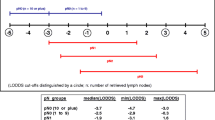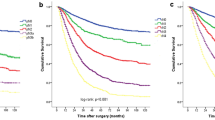Abstract
Background
This study was designed to analyze the prognostic significance of the staging system based on the ratio of metastatic lymph nodes (TRM) compared with the TNM staging system in patients with gastric cancer.
Methods
We reviewed the data of 219 patients who underwent gastrectomy for node-positive M0 cancer. Node Ratio (NR) categories (NR1: 1–15%; NR2: 16–40%; NR3: >40%) were determined by the best cutoff approach at log-rank test. After confirming the prognostic validity of NR in a collinearity-free Cox regression analysis, among different combinations of pT and NR categories we selected five prognostically homogeneous TRM classes. To compare the prognostic power of the TRM vs. TNM systems, we plotted TRM and TNM classes against the mortality estimates.
Results
Both of the TRM and TNM classifications significantly stratified patients outcomes (p < 0.0001), but the TRM system identified prognostic subgroups more homogeneous than the TNM system.
Conclusions
The TRM staging system is a simple and reliable tool to stratify patients with gastric cancer and has a higher prognostic power than the current system.



Similar content being viewed by others
References
Sobin LH (2001) TNM: principles, history, and relation to other prognostic factors. Cancer 91:1589–1592
Siewert JR, Bottcher K, Roder JD et al (1993) Prognostic relevance of systematic node dissection in gastric carcinoma. Br J Surg 80:1015–1018
Degiuli M, Sasako M, Ponti A et al (2004) Survival results of a multicentre phase II study to evaluate D2 gastrectomy for gastric cancer. Br J Cancer 90:1727–1732
Smith DD, Schwarz RR, Schwarz RE (2005) Impact of total lymph node count on staging and survival after gastrectomy for gastric cancer: data from a large US-population database. J Clin Oncol 23:7114–7124
Cuschieri A, Weeden S, Fielding J et al (1999) Patient survival after D1 and D2 resections for gastric cancer: long-term results of the MRC randomized surgical trial. Surgical Co-operative Group. Br J Cancer 79:1522–1530
Bonenkamp JJ, Hermans J, Sasako M et al (1999) Extended lymph-node dissection for gastric cancer. N Engl J Med 340:908–914
Siewert JR, Bottcher K, Stein HJ et al (1998) Relevant prognostic factors in gastric cancer: ten-year results of the German Gastric Cancer Study. Ann Surg 228:449–461
Takagane A, Terashima M, Abe K et al (1999) Evaluation of the ratio of lymph node metastasis as a prognostic factor in patients with gastric cancer. Gastric Cancer 2:122–128
Hyung WJ, Noh SH, Yoo CH et al (2002) Prognostic significance of metastatic lymph node ratio in T3 gastric cancer. World J Surg 26:323–329
Bando E, Yonemura Y, Taniguchi K et al (2002) Outcome of ratio of lymph node metastasis in gastric carcinoma. Ann Surg Oncol 9:775–784
Inoue K, Nakane Y, Iiyama H et al (2002) The superiority of ratio-based lymph node staging in gastric carcinoma. Ann Surg Oncol 9:27–34
Cheong JH, Hyung WJ, Shen JG et al (2006) The N ratio predicts recurrence and poor prognosis in patients with node-positive early gastric cancer. Ann Surg Oncol 13:377–385
Rodriguez Santiago JM, Munoz E, Marti M et al (2005) Metastatic lymph node ratio as a prognostic factor in gastric cancer. Eur J Surg Oncol 31:59–66
Kunisaki C, Shimada H, Nomura M et al (2005) Clinical impact of metastatic lymph node ratio in advanced gastric cancer. Anticancer Res 25:1369–1375
Marchet A, Mocellin S, Ambrosi A et al (2007) The ratio between metastatic and examined lymph nodes (N ratio) is an independent prognostic factor in gastric cancer regardless of the type of lymphadenectomy: results from an Italian multicentric study in 1853 patients. Ann Surg 245:543–552
Liu C, Lu P, Lu Y et al (2007) Clinical implications of metastatic lymph node ratio in gastric cancer. BMC Cancer 7:200
Celen O, Yildirim E, Berberoglu U (2007) Prognostic impact of positive lymph node ratio in gastric carcinoma. J Surg Oncol 96:95–101
Persiani R, Rausei S, Biondi A et al (2008) Ratio of metastatic lymph nodes: impact on staging and survival of gastric cancer. Eur J Surg Oncol 34:519–524
Japanese Gastric Cancer Association (1998) Japanese classification of gastric carcinoma. 2nd English edn. Gastric Cancer 1:25–30
Sobin LH, Witteking C (2002) TNM classification of malignant tumors, 6th edn. Wiley-Liss, New York
McCulloch P, Niita ME, Kazi H et al (2005) Gastrectomy with extended lymphadenectomy for primary treatment of gastric cancer. Br J Surg 92:5–13
Wang X, Wan F, Wang JJ (2008) A common misuse of stepwise regression in studies of ratio of metastatic lymph nodes for gastric cancer. Ann Surg Oncol 15:1805–1806
Kim SH, Karpeh MS, Klimstra DS et al (1999) Effect of microscopic resection line disease on gastric cancer survival. J Gastrointest Surg 3:24–33
Cho BC, Jeung HC, Choi HJ et al (2007) Prognostic impact of resection margin involvement after extended (D2/D3) gastrectomy for advanced gastric cancer: a 15-year experience at a single institute. J Surg Oncol 95:461–468
Oñate-Ocaña LF, Méndez-Cruz G, Hernández-Ramos R et al (2007) Experience of surgical morbidity after palliative surgery in patients with gastric carcinoma. Gastric Cancer 10:215–220
Miner TJ, Jaques DP, Karpeh MS et al (2004) Defining palliative surgery in patients receiving noncurative resections for gastric cancer. J Am Coll Surg 198:1013–1021
Author information
Authors and Affiliations
Corresponding author
Rights and permissions
About this article
Cite this article
Persiani, R., Rausei, S., Antonacci, V. et al. Metastatic Lymph Node Ratio: A New Staging System for Gastric Cancer. World J Surg 33, 2106–2111 (2009). https://doi.org/10.1007/s00268-009-0157-5
Published:
Issue Date:
DOI: https://doi.org/10.1007/s00268-009-0157-5




